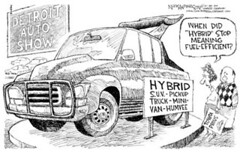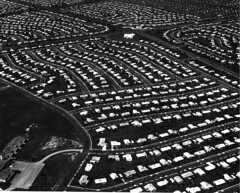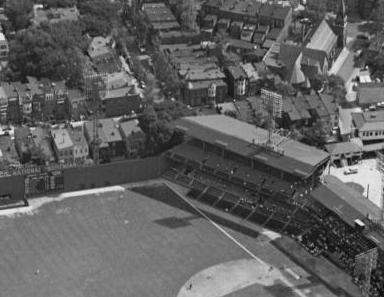The (Bad) Habit (Virginia Mobility roundup)
 Nick Anderson, Houston Chronicle.
Nick Anderson, Houston Chronicle.Today's Richmond Times-Dispatch has many articles about transportation and traffic issues, as well as an editorial entitled "The Habit." The editorial, focusing on fuel efficiency, misses the real point. From the editorial:
Breaking the cycle of addiction, however, is a far more daunting prospect than many might assume. Consider: Each year Americans buy about 17 million new cars. The number of hybrid vehicles, while growing, remains minusule -- about 206,000 last year -- around 1 percent. That's a considerable improvement over the 9,000 hybrids sold in 2000, but hardly likely to put much of a dent in oil consumption. Raising fuel-efficiency standards would have a much greater impact but it also would cause a much greater impact on drivers involved in accidents, because the simplest way to raise fuel efficiency is to make cars smaller and lighter, and therefore less safe.
______
The simplest way to raise fuel efficiency is to not drive at all. This reduces the use of oil significantly.
As long as the land use paradigm requires some form of transportation to get around to do most anything, and the deconcentration that prevails makes efficient public transportation options quite difficult, even with the most efficient vehicles possible, the U.S. would continue to consume great quantities of oil.
Compact (re)development is the answer. Not hybrid vehicles.
 Levittown, Pennsylvania.
Levittown, Pennsylvania. Compact development near Griffith Stadium, 1955 (around the same time of the Levittown photo). Charles Baptie Historic Aerial Photograph Collection, George Mason University.
Compact development near Griffith Stadium, 1955 (around the same time of the Levittown photo). Charles Baptie Historic Aerial Photograph Collection, George Mason University.________
The Op-Ed page of today's Times-Dispatch has three pieces about the transportation issues that Governor Kaine has raised with the Virginia State Legislature, which is in session for about another week: Fortunately, There's Time to Craft a Compromise by TRIP POLLARD; Stalemate Places Drivers in Jeopardy . . . by MARTHA ROWE MITCHELL; and Gridlock! Transportation Challenge Carries Steep Cost by PHILIP SHUCET.
Pollard, the director of the Land and Community Project for the Southern Environmental Law Center, makes the point that debate is focusing on the amount of money and how much money, but not how to spend the money. He recommends refocusing, with six suggestions, although I haven't included four and five, because point four is encompassed in point six, and point five is under-explained and therefore seemingly nonsensical:
•Funding must be increased for alternatives to driving everywhere for everything, including public transit, passenger and freight rail, bicycle lanes, and pedestrian improvements. These alternatives reduce congestion, are cheaper and less destructive than new roads, and can provide better services for elderly, disabled, and low-income citizens... Any transportation package should provide a greater share of funding for greater transportation choices.
• We must get more out of our existing roads by better managing travel. Steps such as improving traffic signal timing and reducing driving by promoting carpooling and telecommuting offer cost-effective measures to relieve congestion.
• Despite recognition from the Governor, Senate, and House that we cannot build our way out of congestion, the biggest share of new funding under current proposals would go to road construction. Costly new projects are teed up, awaiting funding, such as three recently approved highways estimated to cost more than $1.8 billion. The flawed studies of these projects largely ignored their sprawl-inducing impacts and less destructive alternatives. Any budget compromise should limit funding for such expensive, damaging proposals. Road funds should be focused on projects maximizing existing infrastructure.
• Finally, transportation must be firmly linked with land use. Too often these work at cross-purposes, with road projects spurring sprawl and congestion, and land-use decisions leading to clogged roads. Although the need to better link transportation and land use is widely recognized, bills introduced this session to address this are useful but modest, and a number of good bills died. New transportation investments should strengthen existing communities rather than encourage growth to spread farther and farther out.
______________
Speaking of better managing travel, there is another article in the paper, "Activists take on I-81 plan," about alternatives to adding lanes to I-81. One proposal from the activists is to divert freight traffic from tractor-trailers to rail. Given the increased demand for oil this makes sense.
 Shenandoah Valley Network simulation of the impact of widening on I-81.
Shenandoah Valley Network simulation of the impact of widening on I-81.I have to admit I haven't been on I-81 very much, I imagine there is a fair amount of truck traffic at all hours. Still, I think a lot more truck traffic throughput can occur through shifting to rail as well as to time-shifting. The roads that are clogged throughout the day are usually empty at night. (Click here for information from the Shenandoah Valley Network's I-81 page and here for the freight rail proposal for the I-81 corridor.)
By shifting more commercial truck deliveries to evening hours, a significant amount of congestion can be eliminated, with virtually no increase in costs.
This can be done most places, not just on I-81.
For example, last year, the Port of Los Angeles finally got the stevedores to agree to evening and I think Saturday hours, rather than their previously only working from 7 a.m. to 4 p.m. By extending the hours of operation, congestion can be reduced. This is not a difficult concept to understand. From Distribution Publications:
PierPASS Inc. has announced that OffPeak, a new program to reduce congestion at the Port of Los Angeles and Port of Long Beach, will begin Saturday, July 23, 2005. OffPeak will allow truck pickup and delivery of cargo to and from the ports at night and on Saturdays. The extra hours of operation will be Monday through Thursday 6pm to 3am, and Saturdays 8am to 6pm. PierPASS was established in 2004 by marine terminal operators of the Port of Long Beach and the Port of Los Angeles as a non profit agency to help reduce traffic congestion and air pollution in and around the ports.
To encourage use of its OffPeak program, PierPASS will charge shippers, consignees, or logistics providers (including NVOCCs) a Traffic Mitigation Fee (TMF) for all containers moving through the ports at peak hours of operation. The TMF will be $40 per TEU (20-foot equivalent unit) or $80 for all containers larger than a 20-foot unit. Peak hours of operation are Monday through Friday 3am to 6pm. The TMF will be used to fund the costs of off peak hour operations which PierPASS estimates will cost marine terminal operators $156 million to $160 million annually.
Index Keywords: sprawl; energy



0 Comments:
Post a Comment
<< Home